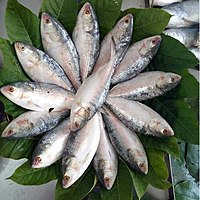
Photo from wikipedia
Background and aims Gout, the most prevalent inflammatory arthritis, has undesirable effects on the quality of life. Omega-3 polyunsaturated fatty acids (n-3 PUFA) has a strong link with anti-inflammatory impacts.… Click to show full abstract
Background and aims Gout, the most prevalent inflammatory arthritis, has undesirable effects on the quality of life. Omega-3 polyunsaturated fatty acids (n-3 PUFA) has a strong link with anti-inflammatory impacts. However, whether the harmful effects of seafood in relation to gout may vary owing to different levels of n-3 PUFA in seafood is still unclear. It was the goal of this study to examine the relationship between n-3 PUFA poor/rich seafood consumption and gout. Methods Between 2007 and 2016, five NHANES cycles were performed, with 12,505 subjects having complete data for gout and two 24-h dietary intake interviews. The 24-h dietary recalls were utilized to evaluate dietary habits. Gout was defined based on questionnaires. Weighted logistic regression models were conducted to investigate the association between n-3 PUFA poor/rich seafood consumption and gout. Moreover, subgroup analysis was utilized to estimate the stability of results. Covariates including age, gender, race/ethnicity, income, education, body mass index, chronic kidney disease, diabetes mellitus, hypertension, smoking status, and drinking status were stratified in different models. Results In the fully adjusted model, each unit of increase of n-3 PUFA poor seafood intake was associated with an 8.7% increased risk of gout (OR = 1.087, 95% CI: 1.039, 1.138, P < 0.001), whereas, no correlation was found between n-3 PUFA rich seafood consumption and gout. It also provided a proof-of-concept regarding the potential for n-3 PUFA rich seafood to counteract harmful effects of purines in relation to gout. A dose-response analysis showed that there was a non-linear relationship between n-3 PUFA rich seafood intake and the risk of gout in the female group. Conclusion Findings suggest that n-3 PUFA poor seafood consumption is associated with higher risk of gout, whereas n-3 PUFA rich seafood is not.
Journal Title: Frontiers in Nutrition
Year Published: 2023
Link to full text (if available)
Share on Social Media: Sign Up to like & get
recommendations!